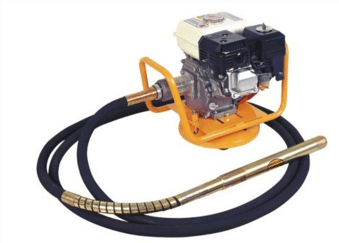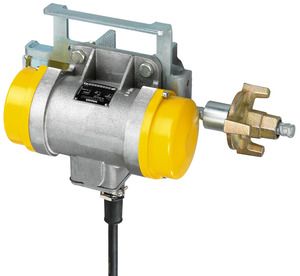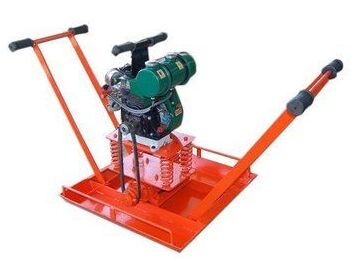What is Vibrator?
On construction sites, vibrators apply to compact concrete. Concrete vibrators come in many different shapes and sizes. Some Concrete Vibrators are smaller, more efficient, and run on battery power, whereas others are much larger and rely on power lines for power. In vibration, compacting is caused by a reduction in internal friction between various concrete particles due to particle oscillation, resulting in a dense and compact concrete mass. Vibrators work for concrete compaction in the roads, trains, and buildings. It compacts fresh concrete by removing trapped air and excess moisture. Its function is to hold the concrete in place in the formwork. And to ensure proper concrete consolidation and the avoidance of product flaws. Vibration frequencies range from 2800 to 15000 pm.
Advantages of Vibrators:
Some of the advantages of vibrators are-
- The honeycomb structure can be avoided.
- Structures with heavy reinforcement can be compacted easily.
- The vibrators can create a dense and watertight structure.
- It is possible to use a low water-cement ratio.
- The rate of work increases.
- It is possible to use a high aggregate cement ratio.
Types of Vibrators:
1. Internal Vibrators:

Fig 1: Internal Vibrator
Courtesy: Civilread.com
These are the most common type of vibrators used in construction. Internal vibrator machines, also known as an immersion or concrete needle vibrators, are commonly used on construction sites. An immersion or needle vibrator is the most commonly used vibrator for concrete. It comprises a steel tube with an eccentric vibrating element (closed and rounded). A steel tube connects to an electric motor, a diesel engine, or a gasoline engine via a flexible tube to form the poker vibrator machine. The poker’s diameter ranges from 40 to 100 mm. The distance between the reinforcing bars in the formwork calculates the poker’s diameter. Internal vibrator machine needle sizes range from 25 mm to 90 mm, with roof slab casting requiring a minimum of 25 mm and a maximum of 35 mm. A vibrator machine with 40 mm and 60 mm needles compact concrete mass in column and beam structures. We should use a vibrator machine with a 75 mm and 90 mm needle to compact the concrete mass by capturing air gaps and preventing honeycomb when proposing a strong footing and various bridge structures. The frequency of vibrations produced by vibrator machines can reach up to 15000 rpm. However, a minimum speed range of 3000 to 6000 rpm is preferred with an accel.
2. External Vibrator:

Fig 2: External Vibrator
Courtesy: Shakedeal.com.
The shutter shape vibrator is another name for the external vibrator. It comes with a base plate. It is used to compact the precast concrete compact surface and the freshly poured foundation. A three-phase induction motor powers it. Its construction has come to an end. It’s also tough, dependable, and easy to maintain, thanks to a power cord made up of four rubber-coated cables. Typically, the casing comprises an aluminum alloy casting. It has a lightweight motor structure that is highly efficient. According to the building pattern, the machine used to form horizontally or vertically at an acceptable spacing of 90 cm in both directions.
3. Vibrating Table:

Fig 3: Vibrating Table
Courtesy: Star Trace Pvt. Ltd.
The vibrating principle of the concrete and formwork remains the same, although formwork joint to the vibrator. The flavor of the vibration is comparable as well. In general, a fast-spinning eccentric weight results in the table vibrating circularly—the system comprises two shafts that spin in opposite directions. A horizontal component of vibration that neutralized was applied to the table. There is only simple harmonic motion in the vertical direction. There are a few minor advantages—high-quality vibrating tables driven by an alternating-current electromagnet. The frequency range achieved is 1,500 to 7000 rpm—a table with different amplitude preferred for various diameters or laboratory purposes to vibrate concrete sections. Variable frequency vibrations are a bonus. Using a vibrating table to compact precast concrete is safe and effective. The benefit of consistent treatment with electrically or pneumatically controlled vibrating tables are ideal for precasting work.
4. Surface Vibrator:
Surface vibrators are attached to the concrete mass permanently. They vibrate the concrete away from the surface during the screening process. It is an excellent choice for the compaction of shallow elements when used with concrete with low water to cement ratio. It is not recommended for use when the depth of the concrete to be vibrated exceeds 250 mm. Even dry

Fig 4: Surface Vibrator
Courtesy: Shakedeal.com
Mixes are compacted with the help of this machine. Pan vibrators and vibrating screeds are examples of surface vibrators. It’s for compacting small slabs, mending, and repairing horizontal surfaces like pavement slabs. It rotates at a rate of around 4000 revolutions per minute.
Conclusion:
Concrete vibrators come in various shapes and sizes, depending on the concrete compaction required for various construction and structural applications. Because concrete contains particles of varying sizes, the best compaction of concrete is possible with the help of vibrators with varying vibration speeds. So, begin your search for the best-suited concrete vibrator type by comparing the brief descriptions of each type provided in this article. By selecting the right vibrator, you will achieve the most efficient results for your project.
References:
- A. (2014, August 22). 4 Different Types Of Concrete Vibrators. Civil Engineers Forum. https://civilengineersforum.com/concrete-vibrator-types/.
- Rajput, K. (2021, June 30). What Is a Concrete Vibrator | 6 Types Of Concrete Vibrators | Concrete Vibrator Alternatives | Advantages Of Concrete Vibrator | Disadvantage Of Concrete Vibrator. CivilJungle. https://civiljungle.com/concrete-vibrators/.
- S. (2015, August 3). 4 TYPES OF VIBRATORS COMMONLY USED FOR CONCRETE COMPACTION – CivilBlog.Org. CivilBlog.Org. https://civilblog.org/2015/08/03/4-types-of-vibrators-for-concrete-used-for-compaction/.
- 4. Ted Worthington. Concrete Construction. Internal Vibrators. https://www.concreteconstruction.net/products/concrete-construction-equipment-tools/internal-vibrators_o
- Types of Concrete Vibrators for Construction. The Constructor. https://theconstructor.org/concrete/types-of-vibrators-concrete-compaction/5157/
- Four Preferred Tools To Vibrate Concrete. (2018, September 12). The Balance Small Business. https://www.thebalancesmb.com/types-of-concrete-vibrators-844554.
- Concrete Vibrator Machine Types, Uses, And Function – Civil Sir. (2020, May 20). Civil Sir. https://civilsir.com/concrete-vibrator-machine-types-uses-and-function/.
- Types Of Concrete Vibrators. (2020, April 16). Blog on procurement of all industrial office supplies | ShakeDeal. https://www.shakedeal.com/blog/types-of-concrete-vibrators/.
If you have a query, you can ask a question here.



Hi
Kindly quote for below item: Include data sheet and cost of freight to Zambia.
1 Concrete vibrator machine with 25mm needle QTY-1 PCS
Regards.
Kennedy